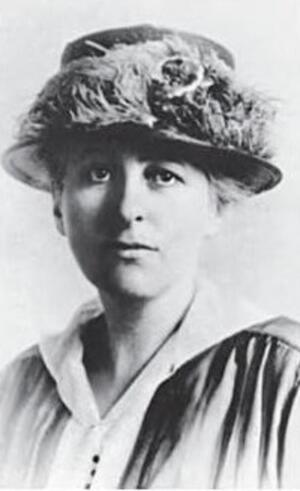Josephine Clara Goldmark
Josephine Goldmark laid the groundwork for transforming American labor laws by amassing data that forced lawmakers to confront the painful realities of factory work. Goldmark briefly taught at Barnard before joining her sister at the National Consumers’ League, where she compiled data on working conditions, wrote articles, led campaigns for legislative reform, and recruited her brother-in-law, Louis D. Brandeis, to argue for those reforms in court. Goldmark went on to write Fatigue and Efficiency, arguing that the workday should be limited because efficiency decreased with exhaustion. From 1912 to 1914, she worked with the Factory Investigating Committee to investigate the Triangle Shirtwaist Fire. She continued her work with NCL until her retirement in 1930, contributing to the laws regulating child labor and the minimum wage.
Josephine Goldmark’s work as a reformer in the Progressive Era did much to redesign the American social contract. Between 1903 and 1930, she shaped laws regulating child labor, the legal length of the working day, and minimum wage. At the National Consumers’ League (NCL) headquarters in New York City, she worked with executive director of the NCL Florence Kelley as chair of the publications committee. In that capacity, she compiled data demonstrating the need for legislation, wrote compelling articles using those data, and helped organize legislative campaigns.
Early Life and Family
Josephine Clara Goldmark was born in Brooklyn, New York, the youngest of ten children and the seventh daughter born to Joseph and Regina (Wehle) Goldmark. Her father, born in Poland and educated in Vienna, was a scientist, member of the Austrian Parliament, and a supporter of the failed liberal revolution of 1848 who immigrated to the United States when the revolution was repressed. Her mother’s well-to-do family emigrated from Prague to Madison, Indiana, in 1849. In 1930, Goldmark wrote a tribute to her parents’ Jewish heritage, their liberal political beliefs, and the close relationship among the Goldmark, Wehle, and Brandeis families—Pilgrims of ’48: One Man’s Part in the Austrian Revolution of 1848 and a Family Migration to America.
After Joseph Goldmark’s death in 1881, two brothers-in-law became important father figures: Felix Adler, founder of the Society for Ethical Culture, who married her eldest sister, Helen Goldmark Adler, in 1880; and Louis D. Brandeis, who married sister Alice Goldmark Brandeis in 1891. Brandeis, a Boston lawyer who in 1916 became the first Jewish justice of the United States Supreme Court, was descended from a family that had migrated from Prague with the Wehle family. His mother was a first cousin of Regina Wehle Goldmark, and he and Josephine Goldmark were descended from the same great-grandfather. Despite their rationalist and assimilationist bent, the Goldmark-Brandeis family retained a strong Jewish identity.
Political Work
After graduating from Bryn Mawr College in 1898, Goldmark studied and taught at Barnard College. Her sister Pauline Goldmark, a staff member of the New York Consumers’ League, introduced her to Florence Kelley. A powerful figure in the burgeoning reform movement sweeping through New York City and the nation, Kelley worked closely with two well-known German Jewish women. She lived at Lillian Wald’s Henry Street Settlement on Manhattan’s Lower East Side and worked with Maud Nathan, a founder of the Consumers’ League movement and head of the New York City league.
Goldmark quickly became Kelley’s indispensable chief assistant at the NCL. Especially important was her success in recruiting Louis Brandeis to defend the league’s legislative program and her work as the compiler of the Brandeis Brief. In 1908, that brief, a watershed event in American legal history, became the basis of the Supreme Court’s acceptance of the constitutionality of an Oregon law that limited the working day of wage-earning women to ten hours. Goldmark’s technique in that brief—the gathering and presentation of socially relevant facts—became the main instrument for shaping American law according to social need rather than judicial precedent.
In Fatigue and Efficiency (1912), a catalog of evidence that showed how efficiency decreased with fatigue, Goldmark launched her career as the author of penetrating studies of working conditions for women and children. Most of these appeared as articles in leading reform periodicals, such as Survey, and were distributed as pamphlets by the NCL. Between 1912 and 1914, Goldmark worked with the Factory Investigating Committee of New York that was appointed after the Triangle Shirtwaist Fire. In 1912, she authored an influential report funded by the Rockefeller Foundation, Nursing and Nursing Education in the United States. However, her most important work continued to be the compilation of dramatic facts and figures that went into the briefs that the NCL submitted in support of its legislative agenda.
In the years prior to her death in December 1950 from a heart ailment, she was living with her sister Pauline in Hartsdale, New York, and working on a biography of Florence Kelley, posthumously published as Impatient Crusader (1953).
Selected Works
“An Adirondack Friendship: Letters of William James.” Atlantic Monthly (September/October 1934).
The Case against Nightwork for Women (1918).
The Case for the Shorter Work Day (1916).
Democracy in Denmark (1936).
Fatigue and Efficiency (1912).
Impatient Crusader (1953).
Nursing and Nursing Education in the United States (1912).
Pilgrims of ’48: One Man’s Part in the Austrian Revolution of 1848 and a Family Migration to America (1930).
AJYB 53:525.
Goldmark family. Papers. Schlesinger Library, Radcliffe College, Cambridge, Mass..
“In Memoriam: Josephine C. Goldmark, 1877–1950.” Social Service Review 25 (March 1951): 111.
National Consumers’ League. Records. Library of Congress.
NAW; Obituary. NYTimes, December 16, 1950, 17:3.
Reverby, Susan M. Ordered to Care: The Dilemma of American Nursing, 1850–1945 (1987).
Urofsky, Melvin I., and David W. Levy, eds. Letters of Louis D. Brandeis. Vol. 1 (1870–1907): Urban Reformer (1971).




